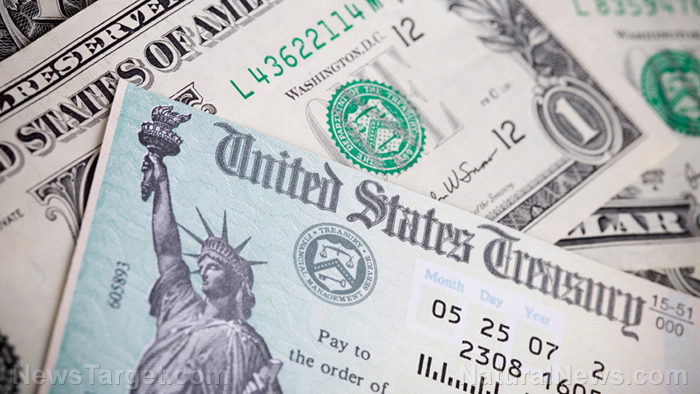High interest rates contribute to the doubling of the federal deficit despite Biden’s claim of “strong economy”
09/12/2023 / By Belle Carter

The federal deficit has been forecasted to skyrocket to double last year’s $1 trillion to roughly $2 trillion for the fiscal year ending Sept. 30, despite President Joe Biden’s claim of robust and improving overall economic growth because of his government measures.
The administration’s claim that the financial status is strengthening came when the deficit dropped by the greatest amount ever in 2022, falling from nearly $3 trillion to roughly $1 trillion. But rather than continue to fall to its pre-Wuhan coronavirus (COVID-19) pandemic levels, the deficit then shot upward, due to record spending by the government. Budget experts now project that it will probably double for this fiscal year, according to the Committee for a Responsible Federal Budget, a nonpartisan group that advocates for lower deficits.
Budget deficits typically shrink when the economy is growing, which tells the truth about the current fiscal situation. “If the deficit is this high when the economy is strong, imagine what it’s going to look like when the economy is weak,” said Marc Goldwein, senior policy director at the budget watchdog group. “I worry very much about our capacity – our political capacity, our economic capacity, our financial capacity, our inflation capacity – to borrow when we need to borrow for the next crisis,” he added.
The Washington Post‘s Jeff Stein reported that the initial figures do not yet include Biden’s hundreds of billions in student debt cancellation policy. The said student loan forgiveness plan was struck down by the Supreme Court this year and never took effect. The U.S. Treasury Department is expected to report the federal deficit to be about $1.7 trillion, reflecting the cancellation of the president’s “student loan amnesty” initiative.
“The unexpected deficit surge, which comes amid signs of strong growth in the economy overall, is likely to shape a fierce debate on Capitol Hill about the nation’s fiscal policies as lawmakers face a potential government shutdown this fall and choices over trillions of dollars in expiring tax cuts,” Stein commented, adding that the deal in June to raise the nation’s borrowing limit that was agreed on by Biden and House Speaker Kevin McCarthy “did little to alter the long-term debt trajectory.” Goldwein thinks that the surging deficit should prompt a serious evaluation of federal policy going forward, “though I worry it won’t.”
Critics opine that the deficit will only weaken Biden’s attempts to take credit for reining in the budget ahead of the 2024 presidential election. At the same time, it could also pose a challenge to Republican lawmakers, who – despite their calls for fiscal responsibility – are pushing to extend more than $3 trillion in tax cuts they approved in 2017.
More reasons behind the national deficit surge
According to analysts, the surge in federal deficit stemmed largely from a sharp decline in tax revenues, coupled with an increase in mandatory spending on Social Security, Medicare, and interest payments, as well as in other areas. (Related: U.S. budget deficit climbs in May amid big government spending and falling revenue.)
Tami Luhby of CNN reported that tax revenue slumped after an unexpectedly strong 2021 due to a soaring stock market and a strong housing market that yielded a bounty of capital gains taxes. The stock market then spiraled down last year and the housing bomb exploded after being hit by rising mortgage rates. This all happened amid the Federal Reserve’s repeated rate hikes.
Tax receipts were an estimated 10 percent lower in the first 10 months of the fiscal year, compared to the same period in the prior year, according to the Congressional Budget Office’s (CBO’s) latest report. At the same time, spending is up 10 percent, compared to the prior year, according to the CBO.
Moreover, Social Security benefits spending jumped to 11 percent because of a hefty annual cost of living adjustment caused by the spike in inflation. More people also joined the entitlement program as the Baby Boomers are aging.
Meanwhile, Medicare outlays increased 18 percent because of changes in payment rates and the types and amount of care beneficiaries received. CBO further reported that spending on Medicaid rose six percent because of a surge in enrollment due to a now-expired congressional provision that barred states from terminating recipients during the COVID-19 public health emergency.
Spending on interest on public debt increased by 34 percent because interest rates are much higher than they were in the first 10 months of fiscal 2022. Expenditures on education, defense, and veterans’ health care services also increased.
CRFB noted that Interest rates on Treasury securities are at or near 16-year highs and are higher than the CBO projected in February. The watchdog said that even if interest rates drift down to the CBO’s estimates, the national debt is “on track to reach a record share of the economy by 2029, and the U.S. will have to shell out $10 trillion in interest payments over the next decade.”
“We made a lot of economic policy assuming that interest rates would always be low and assuming that revenue would be strong,” Goldwein said. “That can change quickly, and when it does, you can’t undo past decisions.”
Follow EconomicRiot.com for updates on the declining United States economy.
Sources for this article include:
Submit a correction >>
Tagged Under:
Bidenomics, big government, Bubble, budget, budget deficit, Collapse, Congressional Budget Office, debt, debt bomb, debt bubble, debt collapse, deficit, economic riot, economy, federal deficit, federal expenditures, government debt, government spending, inflation, interest rates, Medicare, mortgages, national debt, recession, Responsible Federal Budget, risk, social security, spending
This article may contain statements that reflect the opinion of the author
RECENT NEWS & ARTICLES
COPYRIGHT © 2018 PANIC.NEWS
All content posted on this site is protected under Free Speech. Panic.news is not responsible for content written by contributing authors. The information on this site is provided for educational and entertainment purposes only. It is not intended as a substitute for professional advice of any kind. Panic.news assumes no responsibility for the use or misuse of this material. All trademarks, registered trademarks and service marks mentioned on this site are the property of their respective owners.




















